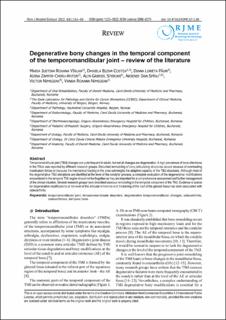Degenerative bony changes in the temporal component of the temporomandibular joint – review of the literature
Vîrlan, Maria Justina Roxana; Costea, Daniela Elena; Păun, Diana Loreta; Zamfir-Chiru-anton, Adina; Sterian, Alin Gabriel; Spînu, Arsenie Dan; Nimigean, Victor; Nimigean, Vanda Roxana
Journal article, Peer reviewed
Published version

Åpne
Permanent lenke
https://hdl.handle.net/11250/3037191Utgivelsesdato
2022Metadata
Vis full innførselSamlinger
- Department of Clinical Medicine [2066]
- Registrations from Cristin [9791]
Originalversjon
Romanian journal of morphology and embryology. 2022, 63 (1), 61-69. 10.47162/RJME.63.1.06Sammendrag
Temporomandibular joint (TMJ) changes are quite frequent in adults, but not all changes are degenerative. A high prevalence of bone alterations in the TMJs was reported by different research groups. Disturbed remodeling of bony articulating structures occurs because of overloading masticatory forces or because the mechanical loading in the area out-weighs the adaptive capacity of the TMJ structures. Although most of the degenerative TMJ alterations are identified at the level of the condylar process, a complete evaluation of the degenerative modifications encountered in the temporal TMJ region should not be forgotten as they are important for a comprehensive assessment and further management of the clinical situation. Several research groups have described osseous remodeling in the temporal component of the TMJ. Evidence is scarce for degenerative modifications at the level of the articular eminence and thickening of the roof of the glenoid fossa has been associated with osteoarthritis.
